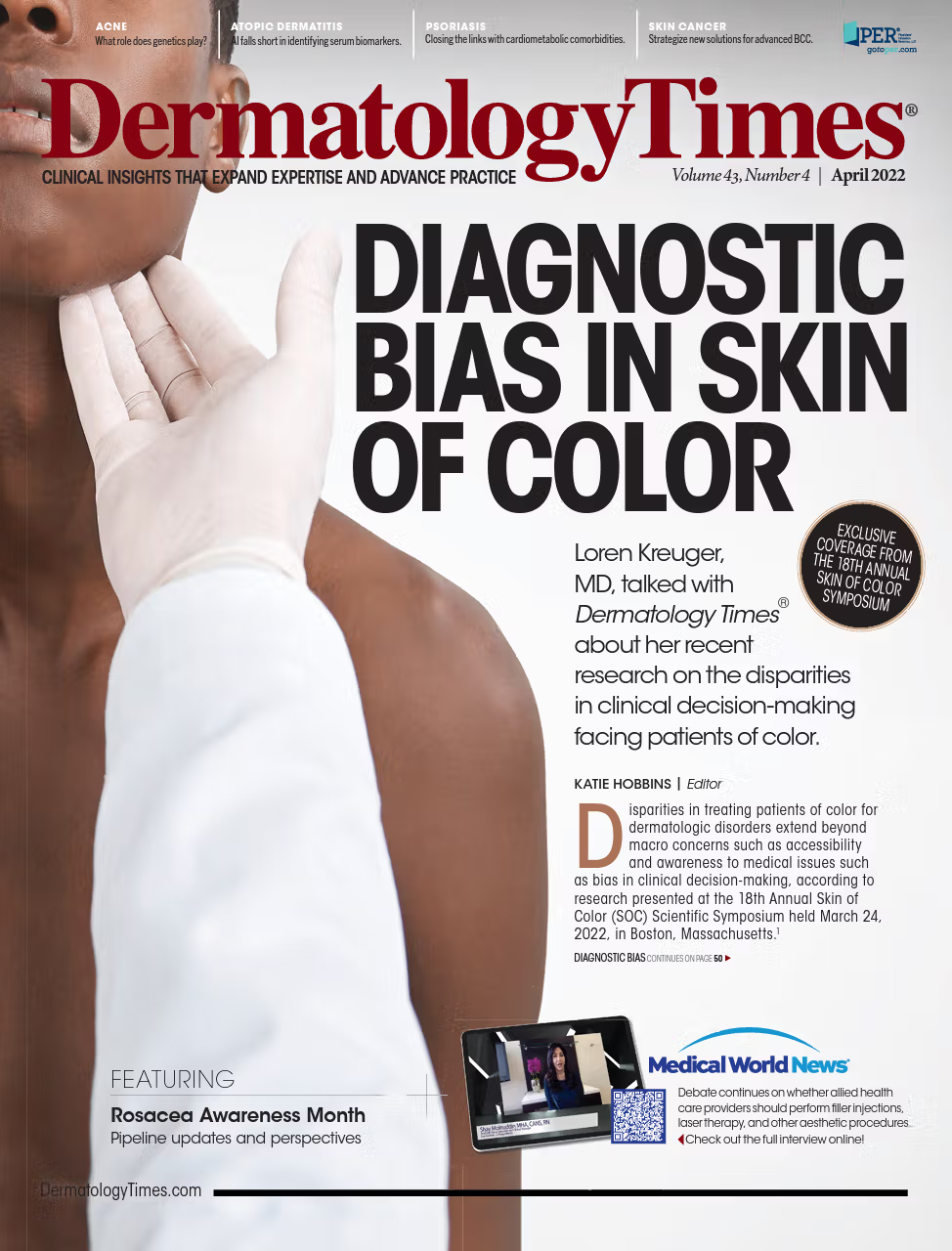- Acne
- Actinic Keratosis
- Aesthetics
- Alopecia
- Atopic Dermatitis
- Buy-and-Bill
- COVID-19
- Case-Based Roundtable
- Chronic Hand Eczema
- Drug Watch
- Eczema
- General Dermatology
- Hidradenitis Suppurativa
- Melasma
- NP and PA
- Pediatric Dermatology
- Pigmentary Disorders
- Practice Management
- Precision Medicine and Biologics
- Prurigo Nodularis
- Psoriasis
- Psoriatic Arthritis
- Rare Disease
- Rosacea
- Skin Cancer
- Vitiligo
- Wound Care
Publication
Article
Dermatology Times
Diverse Perspectives in Medical Aesthetics Matter More Than Ever
Author(s):
Dermatology Times® invites medical professionals in the dermatology community to speak out on the vital issues facing the specialty.
Evolving consumer attitudes about beauty and aging are driving rapid changes in the medical aesthetics industry. The COVID-19 pandemic hascontributed significantly to a surge in demand, leading to more widespread acceptance and awareness of elective procedures.
The American Academy of Facial Plastic and Reconstructive Surgery estimates that impacts of the pandemic have led to a 10% increase in cosmetic surgery, pointing to the “Zoom effect” and increased disposable income as major contributing factors in changing consumer behaviors.1 Further, self-care has become normalized—even an indicator of pride and confidence. With minimally invasive procedures increasingly incorporated into everyday beauty routines, aesthetics is no longer viewed as a luxury for a small demographic.
This increased demand positions the global medical aesthetics market to grow by 12% to 14% annually over the next 5 years.2 As the industry continues to advance with the next generation of products and procedures, dermatologists and aesthetic physicians also must adjust to meet the evolving and diverse needs of a growing patient population that includes people of all racial, ethnic, socioeconomic, gender, and age groups.
Recognizing the Needs, Goals of a Diverse Patient Base
More than 15.5 million cosmetic procedures were performed in 2020. Of that total, the American Society of Plastic Surgeons’ 2020 Plastic Surgery Statistics Report estimates that 86% were minimally invasive. The findings also show that in 2020, 1.78 million Black Americans opted for cosmetic procedures, a number rising annually from 1.68 million in 2018 and 1.77 million in 2019.3
Meanwhile, the medical aesthetics industry has done little to understand the unique aesthetic needs and desires of Black Americans. Treatment of facial aging patterns among White patients is well documented, but there is far less information on how facial injectables and dermal fillers affect Black skin.4
Perceptions that ethnic minorities do not have the same aesthetic concerns or means to address them continue. Narrow definitions of beauty do not necessarily reflect ethnic and aesthetic preferences of diverse populations around the world.
Recently, an advisory board of 10 leading dermatologists and aesthetic physicians from across the globe used a modified version of the Delphi method to establish a strong consensus ongood skin quality.Members accessed an online platform to review peers’ statements on skin quality criteria, including treatment and measurement options, and voted to indicate whether they agreed or disagreed.
These can be described across all ethnicities, age groups, and genders by 4 emergent perceptual categories related to skin: tone evenness, surface evenness, firmness, and glow.5
These findings highlight the need for a more individualized approach to treatments that affect the skin—an integral part of one’s identity—and for broadening the scope of clinical trials to address the aesthetic concerns and treatment priorities of patients of all racial and ethnic backgrounds.
As individuals from a widening spectrum of age groups, socioeconomic, ethnic, and racial backgrounds seek medical aesthetic treatments1 to help them look and feel better, the industry must do a better job of keeping pace.
Making an Impact in Dermatology
Given the need to recognize important dermatologic conditions across a diverse patient base, educational resources have evolved to better equip health care professionals to meet the needs of patients with different skin types and of ethnic backgrounds. Yet, while a younger, more diverse demographic is embracing noninvasive aesthetic treatments, the lack of health care providers and aesthetic professionals with the requisite background and training to understand the needs of people with different skin tones is disheartening.
Dermatology is one of the least diverse medical specialties.6 Black dermatologists make up just 3% of all dermatologists, an especially low proportion considering that more than 13% of the American population identify as Black or African American.7
We need more providers who have experience and education in the special needs of skin of color, and that means training more people with diverse backgrounds as well as adjusting curricula for everyone entering the field. The next generation of providers must be equipped with the appropriate diagnostic and therapeutic tools to address the individual needs of patients seeking medical aesthetic interventions. To move away from the narrow viewpoints holding sway and build deeper respect for the preferences of diverse populations, medical training must expose practitioners to many points of view and a range of skin types, age groups, and ethnicities.
Taking Action Steps in Aesthetic Medicine
Our industry should widen its perspective on innovation and work diligently to foster inclusivity and gain a deeper understanding of where barriers and implicit bias exist in education and our offerings to patients. Collaborating with communities of color and promoting mentorship to bring a new, more diverse generation of health care providers into aesthetic medicine are of paramount importance as the constituency of the patient population expands.
Failure to solve these patients’ concerns would be a missed opportunity for all.
To encourage more people of color to pursue careers in medical aesthetics, more people of color, especially Black women, should be seen in leadership positions. Elevating individuals who recognize the value of diverse voices, inclusivity, and well-being as leaders will spark creativity, encourage unique thinking, and drive innovation within the field. Definitions of beauty need to evolve, and “normalizing” to a single standard based on a narrowly defined population must stop. It is past time to celebrate the unique features of the patients we serve and promote diversity in aesthetic medicine.
Looking Ahead
The aesthetic industry is specially poised to champion a diversity of patients and support the continued advancement and success of our industry. It is time to embrace the shifting consumer behaviors driving change and optimize the needs of all patients, delivering greater confidence to all who seek aesthetic treatments.
Disclosure:
The study “Skin Quality—A Holistic 360 View: Consensus Results,” was sponsored by Merz Aesthetics in Raleigh, North Carolina.Phillips is the chief medical affairs officer at Merz Aesthetics.
References:
1. AAFPRS announces annual survey results: a look athow COVID-19 disrupted facial plastic surgery & aesthetics. News release. American Academy of Facial Plastic and Reconstructive Surgery (AAFPRS). February 1, 2021. Accessed March 7, 2022. https://www.aafprs.org/Media/Press_Releases/PageTemplates/New%20Survey%20Results%20Announced%20Feb.%201,%202021.aspx
2. Leclerc O, Peters N, Scaglione, Waring J. From extreme to mainstream: the future of aesthetics injectables. McKinsey & Company. December 20, 2021. Accessed March 7, 2022. https://www.mckinsey.com/industries/life-sciences/our-insights/from-extreme-to-mainstream-the-future-of-aesthetics-injectables
3. American Society of Plastic Surgeons. Plastic surgery statistics report. 2021. Accessed March 7, 2022. https://www.plasticsurgery.org/documents/News/Statistics/2020/plastic-surgery-statistics-full-report-2020.pdf
4. Alexis A, Boyd C, Callender V, Downie J, Sangha S. Understanding the female African American facial aesthetic patient. J Drugs Dermatol. 2019;18(9):858-866.
5. Goldie K, Kerscher M, Fabi SG, et al. Skin quality - a holistic 360° view: consensus results. Clin Cosmet Investig Dermatol. 2021;14:643-654. doi:10.2147/CCID.S309374
6. Akhiyat S, Cardwell L, Sokumbi O. Why dermatology is the second least diverse specialty in medicine: how did we get here? Clin Dermatol. 2020;38(3):310-315. doi:10.1016/j.clindermatol.2020.02.005
7. Pandya AG, Alexis AF, Berger TG, Wintroub BU. Increasing racial and ethnic diversity in dermatology: a call to action. J Am Acad Dermatol. 2016;74(3):584-587. doi:10.1016/j.jaad.2015.10.044

Newsletter
Like what you’re reading? Subscribe to Dermatology Times for weekly updates on therapies, innovations, and real-world practice tips.






























